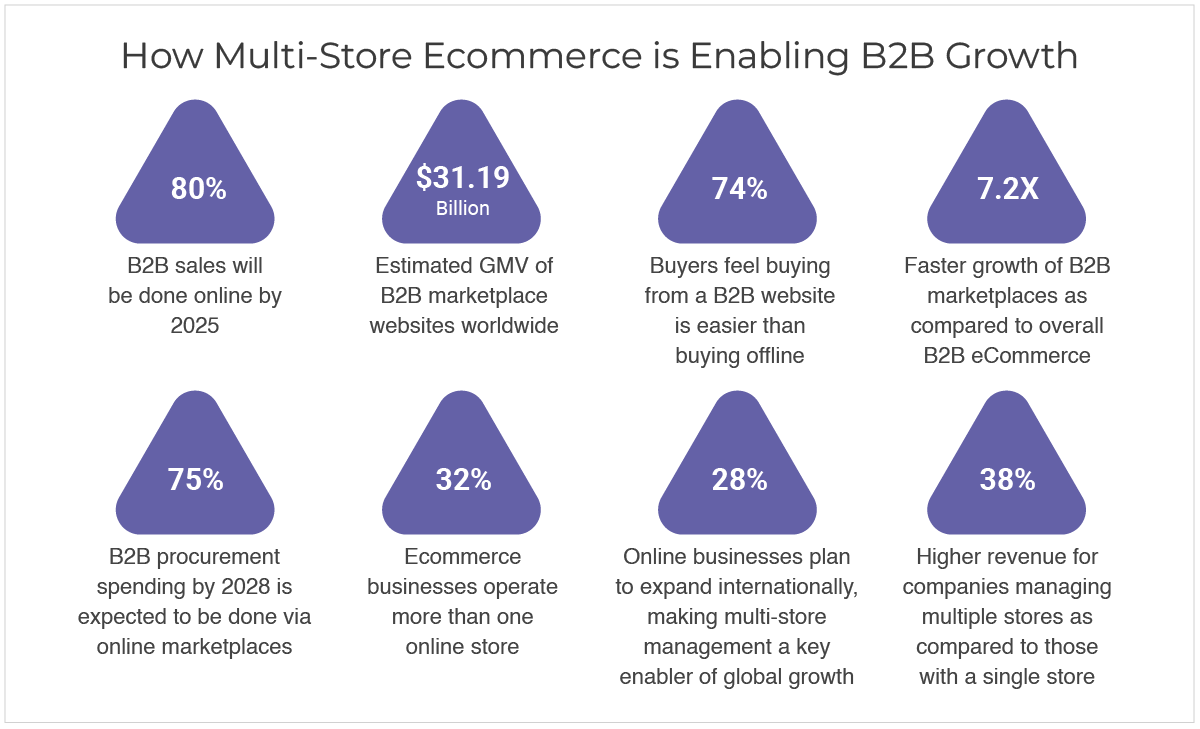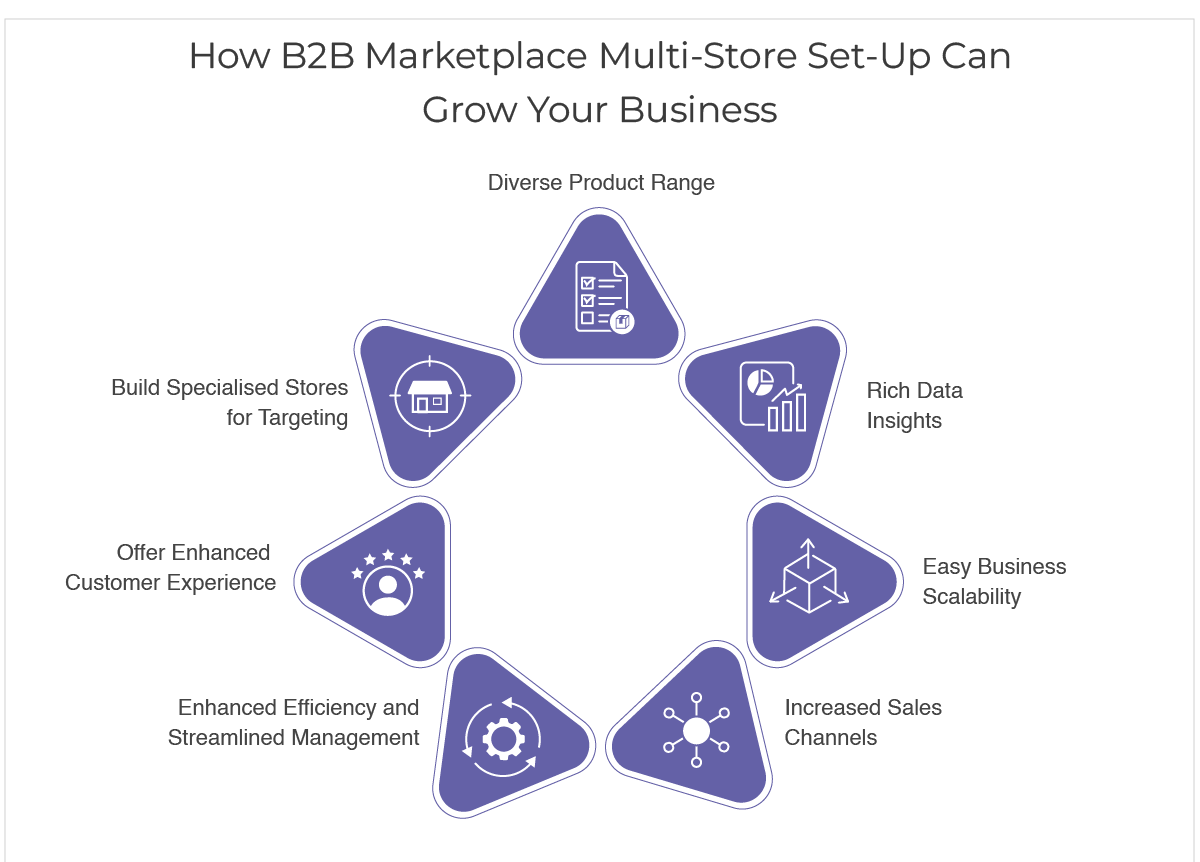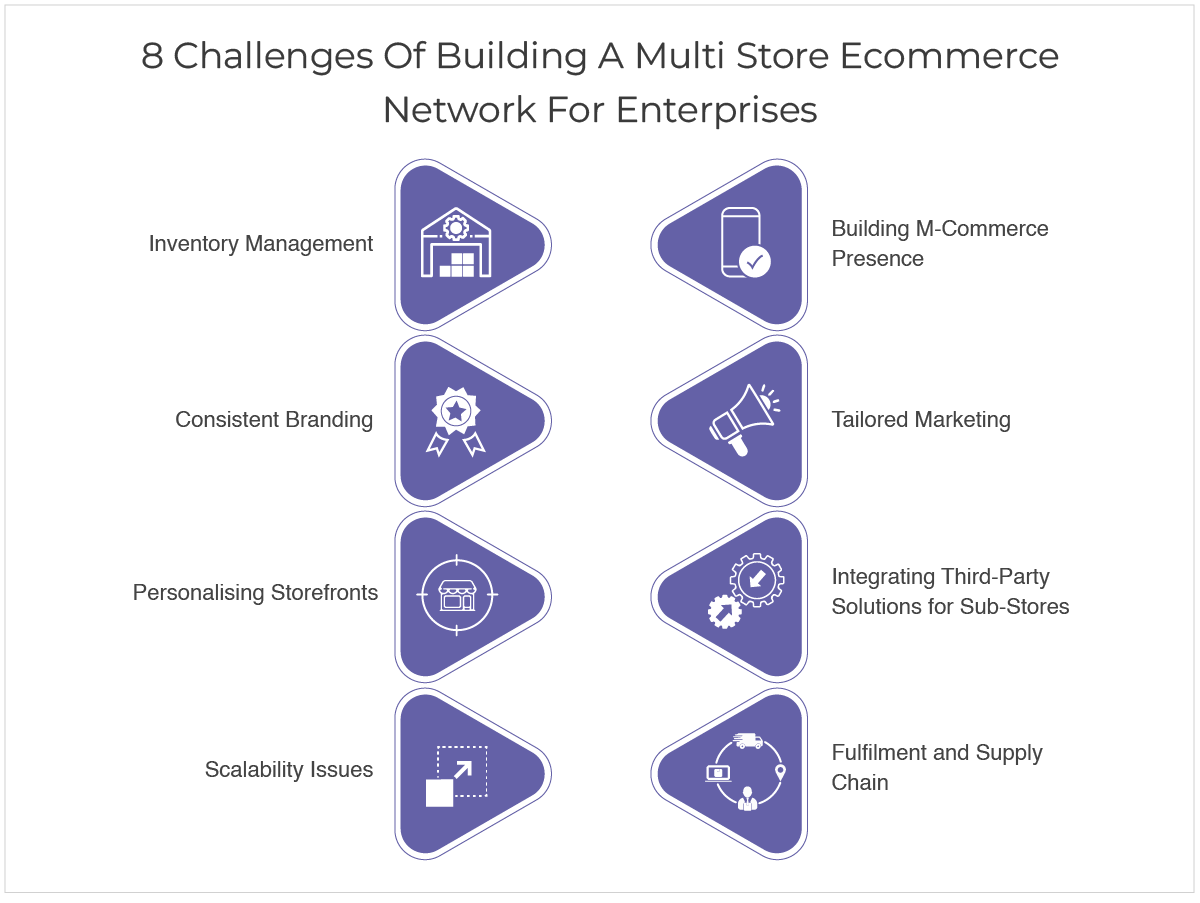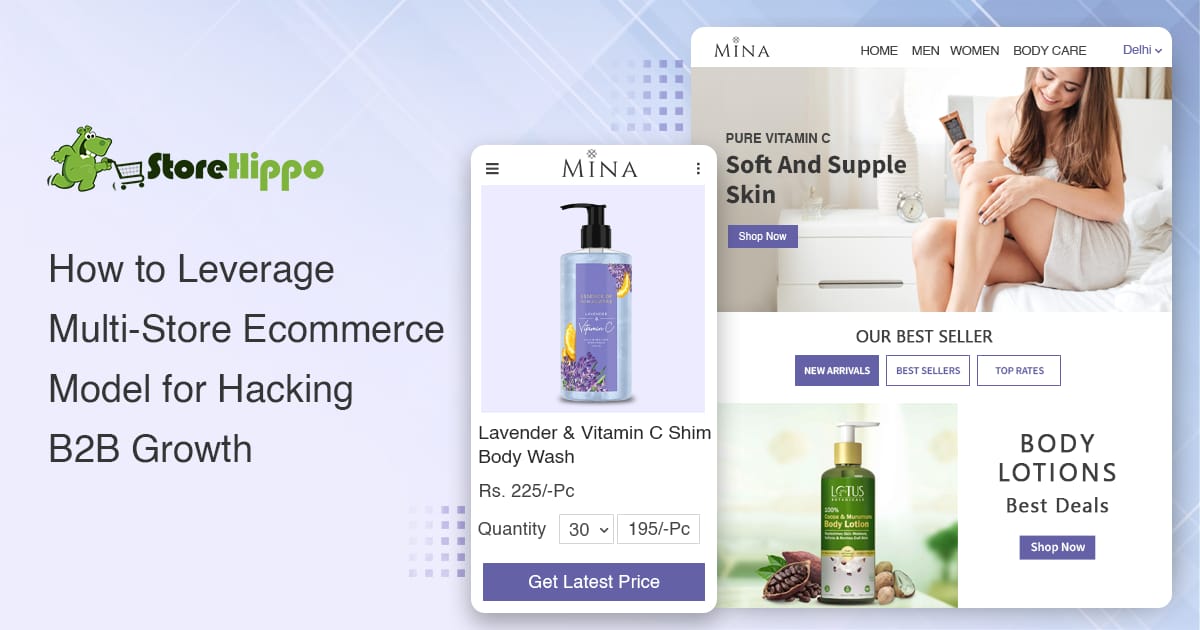If your enterprise B2B business has been successfully running its online brand store for a while, you might consider multi-store ecommerce as the next step in your growth strategy. Whether you are planning to add new products by onboarding new distributors or growing to new domestic and international markets, building a multi-storefront B2B marketplace is an idea worth considering.
Multi-store ecommerce enables you to launch several online stores each for a targeted audience, product or geography. This unique set-up can transform your brand presence by enabling you to differentiate brands, products and audience segments and offer tailored solutions that engage converts and retain your buyers.
Additionally, good multi-storefront ecommerce software gives you centralised control and effective tools to experiment with your marketing and branding.
However, before you take the plunge and build a multi-storefront B2B marketplace, let us deep dive into current ecommerce trends for B2B, challenges and opportunities ahead for enterprises building their multi-store ecommerce platform.
Table of Contents
- How Multi-Store Ecommerce Is Key To Accelerating B2B Growth
- What is Multi-Store Ecommerce
- What are some B2B Marketplace use cases where Multi-Store Ecommerce will be helpful
- 7 B2B Businesses that Can Leverage Multi-StoreEcommerce Model Successfully
- How B2B brands can leverage Multi-Storefront Ecommerce to Accelerate Growth
- Challenges of Building a Multi-Storefront B2B Marketplace Website
- Why Choose StoreHippo for Building Your Multi Storefront B2B Ecommerce Marketplace
- Conclusion
- FAQ
How Multi-Store Ecommerce Is Key To Accelerating B2B Growth
While B2B enterprises were gradually adopting ecommerce, the pandemic disruptions accelerated this shift, making ecommerce essential for survival and growth. Opting for hybrid models, like combining the multi-store model with B2B sales opens up new growth opportunities for B2b brands.
Here is how the market trends further highlight the growing importance of creating a unique hybrid model for B2B enterprises planning disruptive growth:

- 80% of B2B sales will be done online by 2025
- $31.19 billion is the estimated GMV of B2B marketplace websites worldwide
- 74% of buyers feel buying from a B2B website is easier than buying offline
- 7.2X faster growth of B2B marketplaces as compared to overall B2B eCommerce
- 75% of B2B procurement spending by 2028 is expected to be done via online marketplaces
- 32% of ecommerce businesses operate more than one online store
- 28% of online businesses plan to expand internationally, making multi-store management a key enabler of global growth
- 38% higher revenue for companies managing multiple stores as compared to those with a single store
Source: Statista, McKinsey, Forbes
The data reveals what B2B customers want- The ease of buying online and niche stores that cater to their specific needs. B2B marketplaces that leverage these trends for building their brand presence and customer relationships can reap gold in the buyer-experience-driven world.
What is Multi-Store Ecommerce
Multi-storefronts become necessary for businesses aiming for long-term growth and presence across product lines or geographies. Managing and growing an offline network of multiple stores can be overwhelming even for large enterprises.
Alternatively, building a strong digital presence through a network of multiple stores, dedicated to diverse product lines, geographies or audience groups can be much easier to manage.
Using a multi-store ecommerce platform your B2B enterprise can build tailored storefronts to improve brand visibility, drive higher engagement and eventually boost conversions. Having multiple stores also helps with targeted marketing and better SEO results that increase the footfall on your multi-store ecommerce network.
What are some B2B Marketplace use cases where Multi-Store Ecommerce will be helpful
Here are some real-life examples of enterprise B2B businesses that can transform their business by opting for multi-storefront marketplaces:
7 B2B Businesses that Can Leverage Multi-StoreEcommerce Model Successfully
1. Fashion and Accessories Wholesale Marketplace
With multi-store ecommerce wholesale fashion apparel and accessories manufacturers that offer white-labeled garments and accessories can create localized stores for different countries, addressing specific market needs, regulations, and language preferences to enhance user experience and engagement.
2. Construction Supplies Distributors-Based B2B Marketplace
By setting up separate storefronts for various construction materials such as plumbing, paints, electrical, and building supplies, a distributors-based B2B enterprise can provide specialized catalogs and offer bulk purchases to different verticals of buyers.
3. Healthcare Equipment Multi Vendor B2B Website
Multi-store setups enable suppliers to segment their offerings for different healthcare sectors like hospitals, clinics, and laboratories, ensuring that each store meets the unique needs of its target audience with appropriate products and information.
4. Automotive Parts Wholesalers
An automotive enterprise brand can create different location-based sub-stores for its B2B marketplace to sell automotive parts through its chain of dealers. Dealers from a given geo-location can be showcased on a sub-store and orders can be fulfilled by routing through the nearest dealer from the client location.
5. Technology Solutions Providers
An enterprise tech-solution provider can create different stores for various software solutions for different industries like education, healthcare, accounting and finance, hospital management, hotel management and more. Each clientele category can be catered to on a different sub-store of the multi-storefront network.
6. Office Supply Companies
A niche B2B marketplace dealing in various office supplies can use a multi-store ecommerce model to set-up different stores for small businesses, large corporations, educational institutions, hospitals, political parties etc. By showcasing custom catalogs and pricing for each category of buyers the office supplies can cater to a wide audience base.
7. FMCG and Groceries Wholesale Marketplace
An FMCG and groceries wholesale B2B marketplace can build stores for different types of clients, such as restaurants, hotels and catering companies, each with tailored product lists, volume discounts, and industry-specific support services.
The multi-store ecommerce marketplace can be leveraged for many different use cases other than this like milk and milk products wholesale manufacturers, diagnostics supplies providers, interior and upholstery brands and many more.
How B2B brands can leverage Multi-Storefront Ecommerce to Accelerate Growth
Building a multi-store network for your B2B marketplace gives you the power to expand your reach, customize each store for specific market segments and streamline your operations for greater efficiency and profitability.

Here is how your enterprise wholesale market can maximize its potential and reach through a network of stores designed for better brand visibility and conversions.
1. Showcase And Sell Diverse Product Range
When your B2B marketplace has a network of sub-stores you can sell a more diverse range of products by assigning unique stores for different product lines. While this strategy helps you build dedicated stores to attract a broader customer base it also helps you in establishing your brand as a market leader with unique offerings.
Here is how a multi-store ecommerce network showing diverse product ranges through its sub-stores can be a market winner:
- Create store-specific catalogs to offer undistracted buyer experience through niche stores.
- Cut the clutter and enhance the visibility of premium products with dedicated stores ensuring that niche items get the attention they deserve and bring in big-ticket sales.
- Go for multi-pricing of the same products in different stores based on the operations or shipping costs thus maximizing margins.
2. Build Specialized Stores for Targeting
Now that you have created many stores for different product lines, what should be the next step to getting more out of your multi-storefront ecommerce set up? Well, it is time to create a unique UI/ UX of these sub-stores on your B2B marketplace for targeting exclusive buyers.
When your enterprise creates niche stores tailored to specific industries or customer segments it enhances your brand relevance and appeal and makes your brand popular through word of mouth publicity by existing buyers and industry specialists.
Here is how building specialized stores for targeting different buyers can grow your wholesale business:
- Give a unique look and feel to each store based on geographical or customer sentiments.
- Experiment with different store-channel-marketing-product mix to offer personalized discounts for higher conversions.
- Leverage data collected from different stores to identify the most successful targeting strategy and replicate it on other stores for better growth.
3. Offer Enhanced Customer Experience
This is the age of winning customers through personalisation. And B2B buyers no longer crave just for personalised pricing, they want a more personalised B2C-like shopping experience.
Building sub-stores for your B2B marketplace enables your brand to create personalized shopping experiences, improving customer satisfaction and loyalty.
Here is how you can enhance your customer experience on your multi-store ecommerce network and make your B2B business your buyers’ favourite:
- Offer transparent personalised pricing by dedicating stores based on the volume-based buyer segments. For example: build stores for small, medium and enterprise buyers. Offer multiple payment and shipping solutions to personalise payment and shipping based on buyer preferences
- Connect better with your buyers by building multilingual sub stores that connect with buyers in their preferred language
- Integrate with best support software to offer your buyers unparalleled support through multiple channels and in their preferred language using third-party multilingual support solutions
4. Enhanced Efficiency and Streamlined Management
When you have a network of sub-stores each dedicated to a buyer segment, location or product lines and you manage these stores with a central admin you get a better visibility into your business.
Centralized management of multiple B2B stores simplifies operations, inventory, and customer service, boosting efficiency. Increased efficiency across your organization along with better visibility helps in reducing costs and wastages.
Here is how a multi-storefront ecommerce set-up for B2B helps in enhancing efficiency and management of business for growth:
- Consolidate vendors inventory on all sub-stores to reduce stockouts and excess inventory and give your distributors better business opportunities.
- Old stock from one sub-store’s distributors/sellers can be pushed to other stores and offered on discounts to clear up old inventory.
- With detailed data from each store's sales and demand B2B marketplaces can accurately forecast demand and align their distributors to manage optimal inventory levels for different markets/locations.
5. Increased Sales Channels
More stores = more sales channels.
With each new sub-store for your brand you multiply your sales channels and position your brand as an industry leader. New sub-stores grow your sales opportunities by expanding your reach and enhancing brand visibility and customer trust across different regions.
With multiple stores catering to different market segments and geographical regions your B2B marketplace can position itself as a market leader.
Here is how a B2B multi-storefront ecommerce set up grows the sales channels for your marketplace and helps in accelerating growth:
- Add new sales channels by building dedicated stores tailored to reach a new buyer or market segment.
- Multiple sub-stores allow for targeted seasonal promotions and campaigns across geographies driving sales during peak periods.
- Create unique sub-stores dedicated to premium business clients providing customized solutions and partnerships thus increasing B2B sales opportunities. For example, create a sub-store where your vendors create custom uniforms for various industrial clients requiring industry specific uniform and safety gears.
6. Easy Business Scalability
Scaling an already successful and popular B2B marketplace requires a multi-pronged approach. While your enterprise can always onboard new vendors/distributors from new locations, in lack of proper visibility these new sellers can get lost in the vast pool of existing sellers.
The most effective way of scaling your wholesale marketplace is to create new sub-stores based on new markets or product lines. With the multi-storefront ecommerce set up you can scale your business easily by adding new stores as the business grows, accommodating new products and market expansions without disrupting existing operations.
Here is how your multi-store ecommerce set up can scale your B2B enterprise marketplace:
- Quickly scale into new untapped regions or markets where your competitors have not yet created a presence and get first mover’s advantage by creating tailored storefronts for each location.
- Scale your product range by creating sub-stores for different product categories or industry verticals that are not currently available on any other online wholesale marketplace.
- Scale to multiple brand stores, each with its own identity, by launching and managing multiple brands under the umbrella of your B2B marketplace brand. For example: create 3 different wholesale sub stores for apparel brands selling unisex clothes, western clothes and Indian traditional clothes.
7. Rich Data Insights
Data is gold and sub-stores are your goldmines.
While your B2B marketplace is also a rich source of customer data and buying behavior insights, having a network of multiple stores gives you more granular insights into your buyers preferences and buying behavior.
Valuable insights collected from different sub-stores catering to different product lines, markets and buyer segments can help you with strategic decision-making and personalized marketing efforts that boost your sales performance.
Here is how a multi-store ecommerce network gives your enterprise brand a goldmine of data to grow your business:
- Easily track the purchasing patterns specific to different customer segments and markets, providing insights to identify the bestselling products and services across markets. Optimize product offerings and marketing strategies with data insights for better sales.
- Promote new product launches in diverse markets after doing test launch through one or few sub stores on your multi-store ecommerce set up. Get granular performance data from different sub-stores to identify successful strategies and best strategies for introducing new products to all the existing markets.
- Analyze data from your sub-stores to develop highly targeted marketing campaigns tailored to the unique needs of each market segment.
Challenges of Building a Multi-Storefront B2B Marketplace Website
While building a multi-store network is a winning strategy for enterprise brands, it comes with its own set of challenges.

We present the most common challenges of building, running and managing a multi-store network and tips to overcome these challenges.
1. Inventory Management
In a multi store setup managing inventory on each store and keeping track of stock across multiple locations, if not done well can lead to discrepancies and stockouts.
How to Handle: Implementing a robust inventory system with real-time updates can solve the problem.
2. Consistent Branding
Even if you are selling diverse products on the multiple storefronts of your B2B marketplace, you need a unified brand image and customer experience across all storefronts. Ensuring consistent branding can be a challenge with a large network of stores.
How to Handle: An advanced multi-store ecommerce platform with built-in design tools, a wow support service and consistent messaging can solve the challenge.
3. Personalizing Storefronts
Along with maintaining a unified brand image, it is also important to personalize each storefront for its unique target audience. Giving each storefront a tailored and personalized look and feel is a challenge.
How to Handle: Go for customizable multi-storefront ecommerce software with a decoupled headless architecture. This will give you better flexibility to implement changes along with enhanced creative control.
4. Scalability Issues
Scaling a multi-storefront B2B marketplace business and building top-notch multi-store solutions that ensure high-performing stores even when you scale exponentially can be challenging.
How to Handle: Opt for a reputed enterprise ecommerce solution that offers elastic scalability and is able to accommodate your business growth. Also ensure your brand maintains its service quality and operational efficiency across all stores.
5. Building M-Commerce Presence
70% of B2B searches begin on mobiles. Creating a mobile app for each sub-store to leverage the m-commerce boom can be challenging and requires substantial funds and development time.
How to Handle: Choose a mobile-first multi-store builder that offers built-in capabilities to create mobile apps without spending additional time or budget.
6. Tailored Marketing
Since each storefront caters to unique B2B audiences, it is essential to create targeted marketing strategies to suit local markets and audience preferences while maintaining overall brand consistency. Creating tailored strategies and executing them across storefronts on your B2B marketplace can be challenging.
How to Handle: Choose a multi-store ecommerce solution that offers built-in marketing and reporting capabilities to help you with strategic data-driven marketing for each sub-store of your Bb marketplace.
7. Integrating Third-Party Solutions for Sub-Stores
Each localized or product-specific sub-store in your multi-storefront network might have its unique set of software or service providers to manage the overall operations smoothly. Integrating ERP, analytics, marketing, accounting or any other software for each sub-store can be challenging.
How to Handle: Building your multi-storefront ecommerce set-up on a platform that enables hassle-free integrations can do the trick.
8. Fulfillment and Supply Chain
Managing a streamlined supply chain for multiple stores translates into handling multiple, dealing with diverse suppliers and logistics partners, managing a fleet of vendor’s delivery boys etc. Handling such a diverse fulfillment set up and ensuring streamlined deliveries for all storefronts can be a challenge.
How to Handle: Go for feature-rich logistics management solutions and multiple reliable logistics partners to ensure streamlined fulfillment and happy customers.
Why Choose StoreHippo for Building Your Multi Storefront B2B Ecommerce Marketplace
StoreHippo enterprise ecommerce solutions comes with built-in support for B2B ecommerce and also has features to manage multiple sub stores from a common central admin. With 300+ enterprise grade features, cutting edge technology and decoupled headless architecture StoreHippo gives you the flexibility and freedom to implement tailored solutions for brand growth.
Here is why you should choose StoreHippo multi-store ecommerce platform to build your B2B marketplace:
- SaaS-based fully hosted and managed platform gives you a stay-on platform and accommodates your business needs
- Inherent flexibility and scalability enable you to grow your business
- Native multi-store solutions enable you to create multiple stores without buying additional subscriptions or premium apps for managing different sub-stores
- Feature to have unique URLs, look, feel, catalogs, pricing and design for each sub-store in your multi-store ecommerce network
- 100+ device-optimized themes to create a unique look and feel for sub-stores
- Built-in product, order and inventory management solutions for managing catalogs and orders on different sub-stores
- Built on mobile-first principle and comes with built-in mobile apps builder using which you can build multiple apps for your sub-stores as well
- Turn your sub-stores into PWAs and also get mobile apps for admins, vendors and delivery boys
- Multilingual support (100+ languages including RTL languages like Urdu, Hebrew, Persian etc.) to create personalized stores that connect with buyers in their native language
- Multi currency payments and invoicing with support for bulk invoicing
- Easily build new customer touchpoints using the same backend logic and APIs of the headless multi-store ecommerce platform
- 300+ API endpoints for seamless integration with chosen software or service provider on each sub-store
- Comprehensive B2B features like tiered pricing, pricing override, RFQ, MOQ, custom forms etc. for bulk selling
- A gamut of built-in marketing tools and reporting engine to help with strategic data-driven marketing
- Tax engine with full GST support, group taxes and tax-based rules
- 60+ pre-integrated payment gateways, digital wallets and store wallet features to offer ease of buying to B2B marketplace buyers
- 30+ pre-integrated logistics partners and built-in delivery boy management solutions for seamless supply chain management
Conclusion
Creating a network of sub-stores for your B2B marketplace goes a long way in differentiating your business from the competition. However, building and maintaining multiple stores can be overwhelming if you do not have the right infrastructure and tech solutions to support your growth plans.
With StoreHippo multi-store ecommerce platform all your worries are taken care of. The enterprise platform takes care to make it easy for your brad to manage, experiment with and create unique sub-stores for your B2B marketplace. Also, with built in support for different business models like B2B, B2C, B2B2C, D2C, hyperlocal commerce and more you can easily pivot to a hybrid business model and have sub-stores to differentiate your brand.
Ready to write a brand new success story with the multi-store ecommerce network as your foundation for disruptive growth? Begin by exploring StoreHippo’s multi-store ecommerce solutions right away. Start your 14-day free trial now.
FAQ
1. Which is the best multi-store ecommerce platform for enterprise B2B brands?
Ans: While there are many multi-store solution providers in the market, most of them offer multi-store management based on apps and extensions. StoreHippo on the other hand, comes with a built-in solution for creating multiple stores and managing them from a central admin.
You can also personalize each of the stores for unique audience/brand requirements, have unique languages, currency, catalogs, shipping, payment and other solutions. Also, you can implement different tax rules for each sub-store or build different sub-stores for different dealers and distributors on your B2B marketplace.
Using StoreHippo’s comprehensive multi-store ecommerce platform you can plan your strategic expansion to new locations, product segments and audiences.
2. How much time will it take to create a network of 5-15 location-based sub-stores for my B2B marketplace?
Ans: The time needed to build 5-15 sub-stores for a multi-store ecommerce network depends on the platform you choose. For ecommerce platforms that require different subscriptions for each store, the time can be in weeks or even months.
However, with StoreHippo you can create stores in no time and then set them up based on unique requirements in 2-3 days.
3. What plugins will we need for customising the sub-stores of my multi-store ecommerce network for different countries?
Ans: You will not need additional plugins or apps for customizing your substores for different countries. You can give different stores country-specific URLs ( like say, www.storename.in, www.storename.de, www.storename.uk etc), add unique store designs, languages etc. you can also set up multi-currency pricing on different stores and add different tax-rules for your international sub-stores in your B2B marketplace. You can also add multiple languages based on buyer-IP or give options to buyers to choose their preferred language. StoreHippo supports 100+ languages including RTL languages.


